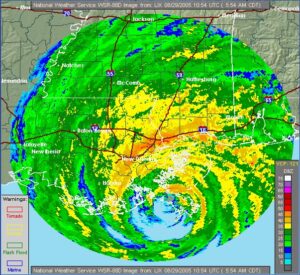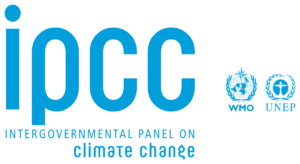
Linda O. Mearns
On November 9th Linda O. Mearns, senior scientist for the National Center of Atmospheric Research, presented uncertainty in climate change.

Radar image of Hurricane Katrina
She began the talk with a memory from hurricane Katrina and the discussion that took place a day after it hit. She met with a panel of scientists who could not stop talking about how “thrilled” they were that their forecast prediction was so accurate. She explained how shocking this was to her that top-notched scientist were only worried about their predictions, rather than the real damage done by the hurricane (lives lost, communities destroyed, etc.). She then questioned, “What good is the most accurate forecast prediction if no one is prepared to cope with it?”
This prompted her research to understand degree of vulnerability through her creation of the “Social Sensitivity to Climate Impacts Index”. This index reflects socioeconomic variables that affect communities sensitivity, vulnerability, and adaptability to potential climate extremes. Climate change typically impacts low-income, minority communities the most. The most vulnerable communities are experiencing extreme weather, exposure to pollution, and live the closest to factories and incinerators. Specifically extreme weather, vulnerable communities have the hardest time with the clean up of aftermath, and getting the healthcare and aid they need. Often times these communities are overlooked, like Mearns experienced when Scientists were discussing the storm.
After Mearns introduction she defined uncertainty and described climate change as a “super wicked problem”. A super wicked problem derives public policy concerns that defy optimal solutions, is characterized by deep uncertainties, and is hard to define. She then discussed the Intergovernmental Panel on Climate Change (IPCC) and their release of statements on climate change over the past two decades. From their website- “The IPCC was created to provide policy makers with regular scientific assessments on climate change, its implications and potential future risks, as well as to put forward adaptation and mitigation options.” Their definitions reflect increasing confidence in the science of climate change. For example in 1990 the IPCC stated, “the observed increase (in temperatures) could be largely due to natural variability; alternatively this variability and other human factors could have offset a still larger man-made greenhouse warning.” In contrast, their more recent statement in 2021 stated “it is indisputable that human activities are causing climate change.” The report requires acceptance by nations that participate in the Panel, which is all 195 countries.

The rest of her presentation consisted of uncertainties about future climate, vulnerability at local scales, and the danger of false certainty. She concluded with, “don’t be afraid of uncertainty.” During the Q&A portion she responded to a question relative to the Paris Agreement, a legally binding international treaty that commits all member states to respond to climate change by keeping the global temperature rise relatively below 1.5 degrees C.
Mearns says, “I don’t think there is a chance in hell that we will stay below 1.5”.